Thermoelastic Analysis of Non-uniform Pressurized Functionally Graded Cylinder with Variable Thickness Using First Order Shear Deformation Theory(FSDT)and Perturbation Method
2015-11-01KHOSHGOFTARMIRZAALIandRAHIMI
KHOSHGOFTAR M J*, MIRZAALI M J, and RAHIMI G H
1 Faculty of Mechanical Engineering, Tarbiat Modares University, Tehran 14115-111, Iran2 Department of Mechanical Engineering, Faculty of Engineering, Arak University, Arak 38156-88349, Iran3 Department of Mechanical Engineering, Politecnico di Milano, Milan 20156, Italy
Thermoelastic Analysis of Non-uniform Pressurized Functionally Graded Cylinder with Variable Thickness Using First Order Shear Deformation Theory(FSDT)and Perturbation Method
KHOSHGOFTAR M J1,2,*, MIRZAALI M J3, and RAHIMI G H1
1 Faculty of Mechanical Engineering, Tarbiat Modares University, Tehran 14115-111, Iran
2 Department of Mechanical Engineering, Faculty of Engineering, Arak University, Arak 38156-88349, Iran
3 Department of Mechanical Engineering, Politecnico di Milano, Milan 20156, Italy
Recently application of functionally graded materials(FGMs) have attracted a great deal of interest. These materials are composed of various materials with different micro-structures which can vary spatially in FGMs. Such composites with varying thickness and non-uniform pressure can be used in the aerospace engineering. Therefore, analysis of such composite is of high importance in engineering problems. Thermoelastic analysis of functionally graded cylinder with variable thickness under non-uniform pressure is considered. First order shear deformation theory and total potential energy approach is applied to obtain the governing equations of non-homogeneous cylinder. Considering the inner and outer solutions, perturbation series are applied to solve the governing equations. Outer solution for out of boundaries and more sensitive variable in inner solution at the boundaries are considered. Combining of inner and outer solution for near and far points from boundaries leads to high accurate displacement field distribution. The main aim of this paper is to show the capability of matched asymptotic solution for different non-homogeneous cylinders with different shapes and different non-uniform pressures. The results can be used to design the optimum thickness of the cylinder and also some properties such as high temperature residence by applying non-homogeneous material.
non-homogenous cylinder, First order Shear Deformation Theory, matched asymptotic method, perturbation method,functionally graded material
1 Introduction*
Functionally graded materials(FGMs) are composite materials made up of various material composition and micro-structures. These properties can vary spatially in FGMs. Structures made of FGMs have improved performance characteristics in terms of mechanical and thermal properties under high temperature and thermal cycling conditions. Recently, application of FGMs as heat-shielding materials have attracted a great deal of interest.
Powder metallurgy methods can be used in the production of FGMs. As an example of such a manufacturing process, they can be produced by the application of a centrifugal force. Using this method, a continuously varying volume fraction of the inclusion material can be formed. The most well-known FGM is compositionally graded from a ceramic to a metal. It is able to incorporate diverse properties of ceramics, such as heat,wear and oxidation resistance, with toughness, strength, machinability and bending capability of metals. It will result in a material with non-homogeneous thermal and mechanical properties. In the theory of elasticity, FGM materials are mostly treated as non-homogeneous materials with material constants that vary continuously along one spatial direction.
The mechanical behavior of homogeneous and non-homogeneous cylinders has been investigated in several scientific papers. NZENGWA and SIMO[1]derived a 2-Dimensional model of a thick elastic shell from the 3-Dimensional theory by considering of different ratios for h/R in horizontal and vertical components. TUTUNCU and OZTURK[2]presented the exact stress solution for spherical and cylindrical pressure vessels of a functionally graded composite. They used infinitesimal theory of elasticity and obtained a close form solution for the stresses. They have considered simple power law for stiffness and constant value for Poisson ratio. TUTUNCU[3]published another paper about finding the stress solution in thick-walled cylinders using power series. Elastic and thermoelastic analysis of functionally graded piezoelectric cylinder have been considered in the literatures[4-8]. Set of field equations for thick shell of revolution made of FGMs derived by ZAMANI NEJAD, et al[9]. They derived formulation for a general shell of revolution and then solved that for a simple cylinder.
LIEW, et al[10], published the analysis of the temperature and thermal stresses in a hollow circular cylinder made of FGM. They used a novel limiting process to obtain the stress solution. In that, they employed the solutions of homogeneous hollow circular cylinders, with no recourse to the basic theory or the equations of non-homogeneous thermo elasticity. JABBARI, et al[11], investigated the thermoelastic behavior of a FG cylinder under the thermal and the mechanical loads. They employed 2-dimensional differential equation of heat transfer for the different boundary conditions. Considering two sets of equilibrium equations in the cylindrical coordinate system and imposing the distribution of temperature, they obtained two Navier equations in terms of two axisymmetric components of displacement.
First order shear deformation theory(FSDT) has been used by other investigators as it gives a satisfactory results in the variety of engineering problems. In this theory, shear deformation is assumed to be constant along the thickness. To achieve more accurate results, it is essential to adopt shear correction factor or use higher-order shear deformation theories. ZHANG et al. applied the FSDT in dynamic analysis of cylindrical shell with clamped ends[12]. SHENG and WANG[13]performed the analysis on FGM cylindrical shells embedded in an elastic medium under combination of different loading scenarios of linear thermal vibration, buckling and dynamic stability. They used the First order Shear Deformation shell Theory for the analysis and assumed a temperature dependent material property in the analysis. TORNABENE, et al[14], adopted first order shear deformation theory and generalized differential quadrature method to study the free vibration analysis of functionally graded conical, cylindrical shells and annular plates. NAJAFIZADEH and ISVANDZIBAEI[15]studied free vibration of thin FGM cylindrical shells with ring support using Ritz method and based on shear deformation shell theory.
From a computational point of view some finite element methods have been proposed in the literature. For instance,a semi-analytical axisymmetric finite element model using the 3D linear elastic theory for free vibrations of functionally graded cylindrical shells has been carried out by SANTOS, et al[16]. GHANNAD and ZAMANI considered a cylindrical shell with clamped ends[17]. They applied First order Shear Deformation Theory and principle of virtual work for modeling of a functionally graded cylinder. They compared their solution with finite element method and showed the effects of boundary on functionally graded cylinder. Perturbation technique has been adopted for a cylindrical shell with variable thickness by GHANNAD, et al[18]. They used matched asymptotic method for the system of ordinary differential equations with variable coefficients. Perturbation theory is a technique for finding an approximate solution to a problem by starting from the exact solution of a related problem. Matched asymptotic method is used in a perturbed problem when the domain is divided into some sub-domains.
Exact solution for a cylinder with finite length made of functionally graded material under non-uniform pressure has been calculated by KHOSHFOTAR, et al[19]. They considered First order Shear Deformation Theory and introduced an analytical method for solving the problem. They also showed the capability of the model for different material distribution and different non-uniform pressure. Unfortunately, this analytical model cannot be used for a cylinder with variable thickness and non-uniform pressure.
The main aim of this paper is to apply the matched asymptotic method for solving the non-homogeneous cylinder with varying thickness and varying pressure along the longitudinal axial of cylinder.
2 Problem Formulation
Consider a cylinder of length L with variable thickness h(x). Assume that it is subjected to non-uniform internal pressure P(x) and temperature T(x, z) that is shown in Fig. 1.
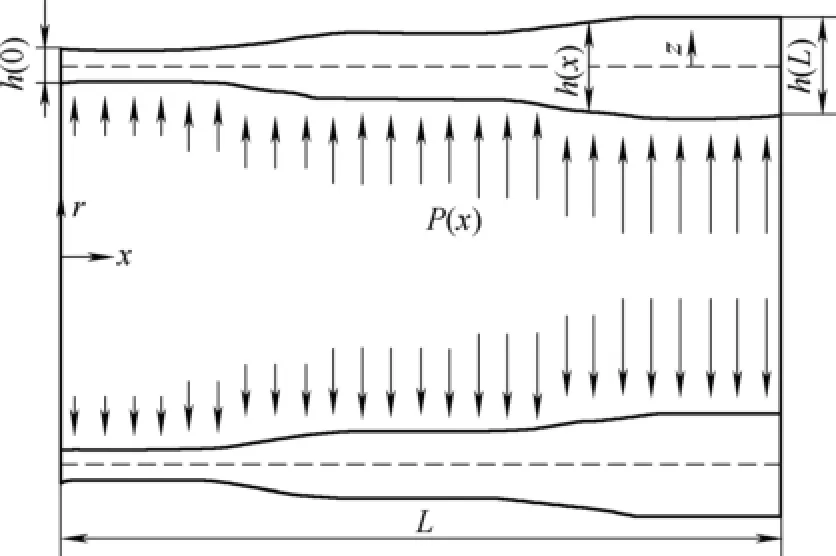
Fig. 1. Schematic of a cylinder with various thickness under non-uniform internal pressure and temperature
The total potential energy functional Π can be obtained from Eq. (1):

The first term in Π represent the strain energy stored in the cylinder that is obtained from Eq. (2):

where A is the cross section area of the cylinder and changes along the length of the cylinder. For isotropic materials the stress-strain relation is given by Eq. (3):

where λ and μ are the Lame constants, T-T0istemperature change that can be evaluated by heat transfer equation in the cylindrical coordinate system[7]and α is the coefficient of linear thermal expansion. Because of symmetry, there is no displacement in θ direction. Therefore, by applying cylindrical coordinate system, the linear strain-displacement relation is given by Eq. (4):

where U and W are displacements along x and z directions. By applying First order Shear Deformation Theory(FSDT), the displacement components can be written as Eq. (5):

Area element dA in the cylindrical coordinate is written as rdrdθ or (Rz)d d,zθ+ where R is the radius of meridian curve. The second term in Π denote the work done on the cylinder by the distributed pressure P(x) that is presented in Eq. (6):

According to principle of minimum total potential energy,we wish to determine the governing equations by using Euler equation as shown in Eq. (7)[20]:

After substituting Eqs. (1)-(6) into Eq. (7), the final form of equations are presented in Eq. (8) where all the components are shown in appendix:

Governing Eq. (8) is a non-homogenous differential equations with variable coefficients. It may be solved by the perturbation technique which is shown in the next section.
3 Solving Procedure
Eq. (8) is a system of non-homogenous differential equations with variable coefficient. This equation can be converted to a dimensionless equation if one uses parameters defined in Eq. (9):
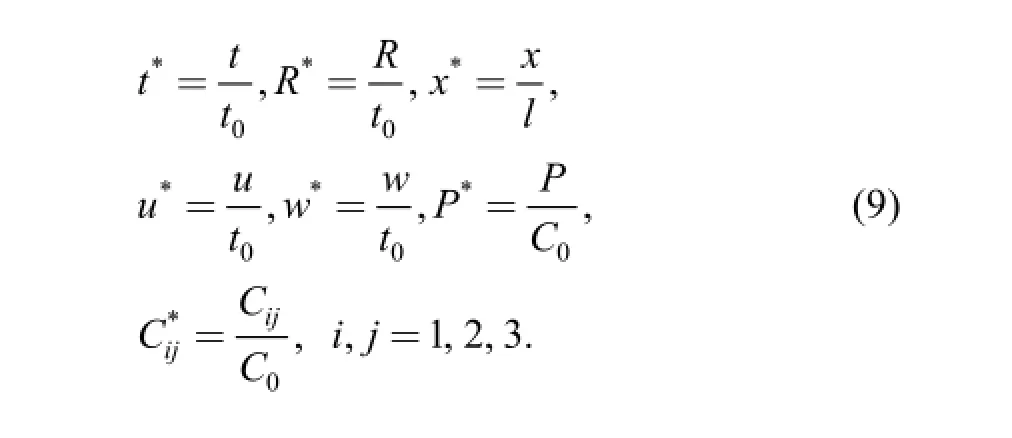
Therefore, Eq. (8) can be rewritten as dimensionless form as it is presented in Eq. (10). All the components can be found in Appendix.

where ε is the small perturbation parameter that is equal to0tl/. Different variables must be used for solving near boundary or inner solution and out of boundary or outer solution. This is due to the faster variation near the boundaries. For outer solution the expansion of Eq. (11)can be applied:

By substituting Eq. (11) into Eq. (10), the equations with the same order can be derived as Eq. (12):
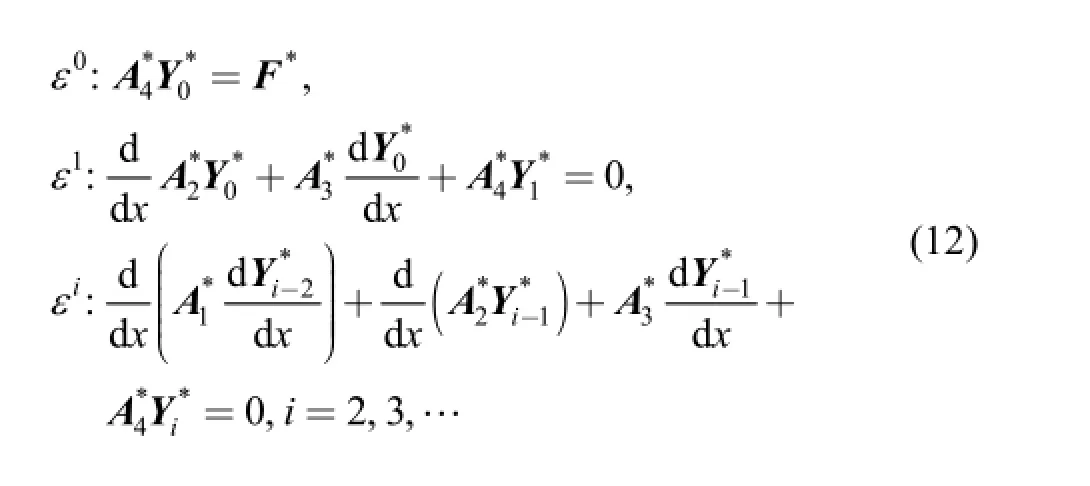
As shown in Eq. (12), the unknown functions of Eq. (11)can be obtained with algebra equations. For the inner solution, it is necessary to select a more sensitive variable to show the faster variations at the boundaries. This variable for two boundaries is shown in Eq. (13):

a=0 presents the beginning and a=1 shows the end of cylinder. By substituting of Eq. (13) into Eq. (10), it can be rewritten as Eq. (14):

According to Taylor expansion, the matrices of coefficients and non-homogenous part can be rewritten as Eq. (15)based on η:

As before, the expansion of Eq. (16) can be considered as the solution of Eq. (14) as inner solution:

After substituting of Eq. (16) into Eq. (14) and considering the same order of ε, the solution of Eq. (14)can be obtained from Eq. (17):
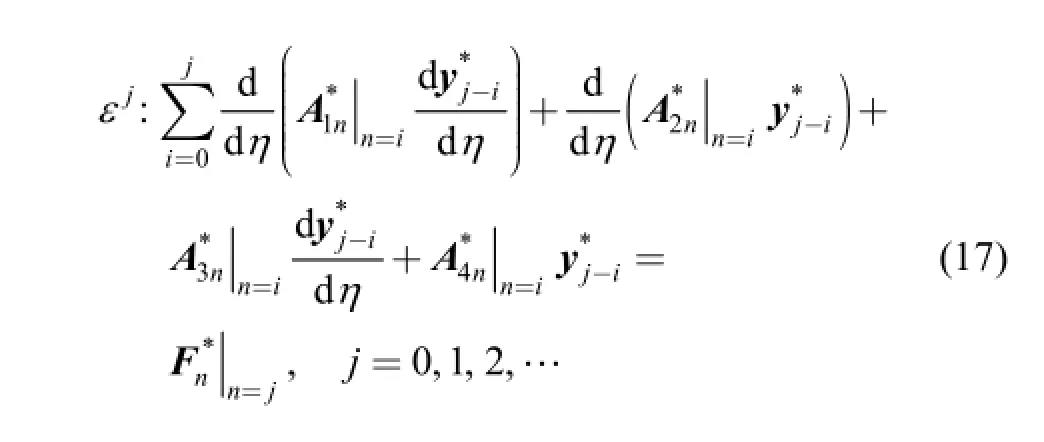
Eq. (17) is a system of non-homogenous differential equations with constant coefficients. The solution can be written as Eq. (18)[19]:


where mjand vjare eigenvalues and eigenvectors of matrix of Eq. (17). There is a need to obtain cjby applying the boundary conditions. There are 16 coefficients for two ends of cylinder. However, there are only 8 boundary conditions available and the other coefficients are zero according to the finite solution. It means when η→∞for x=0 and η→-∞ for x=1. Particular solution for non-homogenous system depends on the F distribution. The trail solutions according to F are substituted into non-homogenous system and the arbitrary components of the coefficient vectors are determined to make the resulting equations identically true[19].
So far, an approximate solution of the boundary layer problem has been given as two separate expansions in terms of outer variable x and inner variable η. The basic idea underlying the method of matched asymptotic expansion is that the domains of validity of the two expansions overlap and hence they match. The final solution can be obtained from Eq. (20) where Joveris over lapping part:

In addition,over,J over lapping solution, can be determinate from Eq. (21):

4 Results and Discussion
In this section some capabilities of the presented method are discussed and the results are compared to other theories. Schematic of cylinders with various thickness under the various internal pressure are illustrated in Fig. 2.
Fig. 3 shows comparison between classical theory, FSDT with analytical solution and current work for a homogeneous cylinder with constant thickness and uniform pressure that is shown in Fig. 2(a). Classical theory cannot show displacement variation along the length of the cylinder and is only able to consider the displacement variation along the thickness. Results obtained from FSDT and classical theory were the same for the points far from the boundaries. Identical results between FSDT and Classical theory were obtained for the mid surface of the cylinder for the points far from the boundaries(Fig. 3(c)). However, there is a high difference near the boundaries(Fig. 3(b)) as the effects of boundaries are not considered in the classical theory. As it is shown, the perturbation method leads to the accurate results according to the analytical method for this case. In one hand, with considering 3 terms of perturbation series, non-dimensional displacement fields calculated from both methods are the same up to the 6 digits. In another hand, there is an error between two methods. Increasing the number of perturbation series terms lead to more accurate results comparing to the analytical solution.
On of the advantages of this model is that we are able to choose different material properties along the thickness without any restriction. For instance, we assumed the material properties varied along the thickness as described in Eq. (22). Different values of n show different distribution of the properties along the thickness.

One of the most interesting functionally graded materials is combination of metal and ceramic. Zirconia(E=244.265 96(GPa)andν=0.288 2)and Ti6AIV(E=122.556 76(GPa)andν=0.28 838 235)are selected for numerical results[21]. The elastic modulus and Poisson ratio variations along thickness of cylinder according to Eq.(22) and selected material are plotted in Fig. 4.
Radial and axial displacements of a cylinder with constant thickness and non-uniform pressure are considered in Fig. 5 and Fig. 6. The corresponding configuration is illustrated in Fig. 2(b). The analytical solution exists forthis case[19]. Comparing the results of the matched asymptotic solution and the analytical results, it can be inferred that both methods follow each other quite well (Fig. 5). In Fig. 5 and Fig. 6 different non-homogeneous and homogeneous cases are presented. Other mechanical components can be determined with displacement field solutions.

Fig. 2. Schematic of cylinders
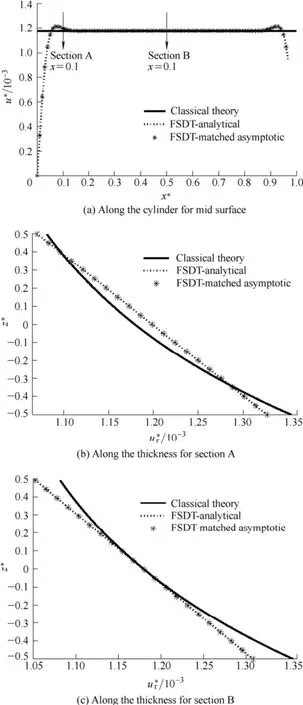
Fig. 3. Dimensionless radial displacement
As another case, a cylinder with variable thickness and uniform pressure is considered in Fig. 7 and Fig. 8. The schematic of the cylinder and applied load is showed in Fig. 2(c). Fig. 7 and Fig. 8 show the radial and axial displacements for the homogeneous cases and their combination with n=1. The axial displacement variation is very fast at the boundaries and it is significant.
Fig. 9 and Fig. 10 show radial and axial displacements of a cylinder with varying thickness under non-uniform pressure. The schematic of the boundary conditions and geometry of the cylinder is shown in Fig. 2(d). Based on the strong capability of the current work, it possible to obtain an optimum design of the cylinder. It will lead to the optimum thickness and optimum properties for the cylinder.

Fig. 4. Mechanical properties distribution along thickness
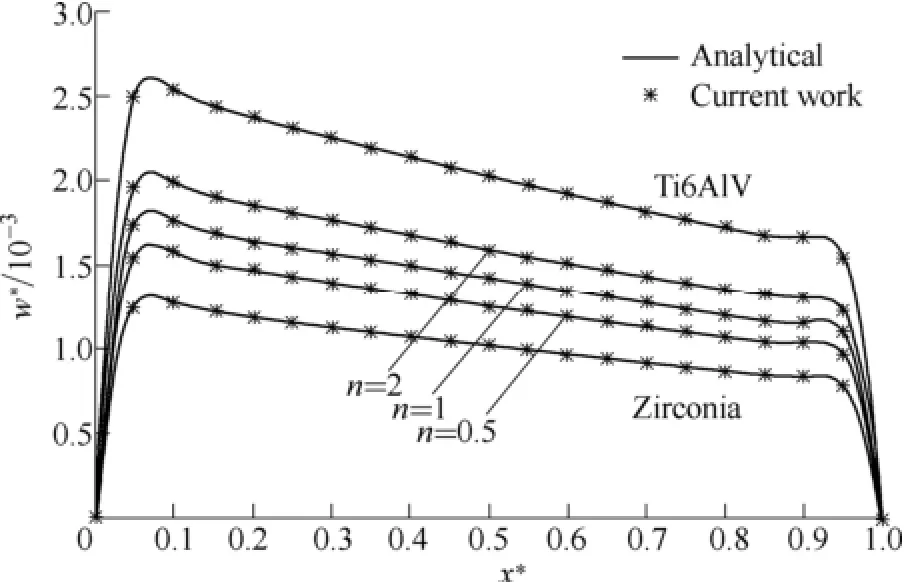
Fig. 5. Dimensionless radial displacement distribution along the inner surface of cylinder with constant thickness and non-uniform pressure
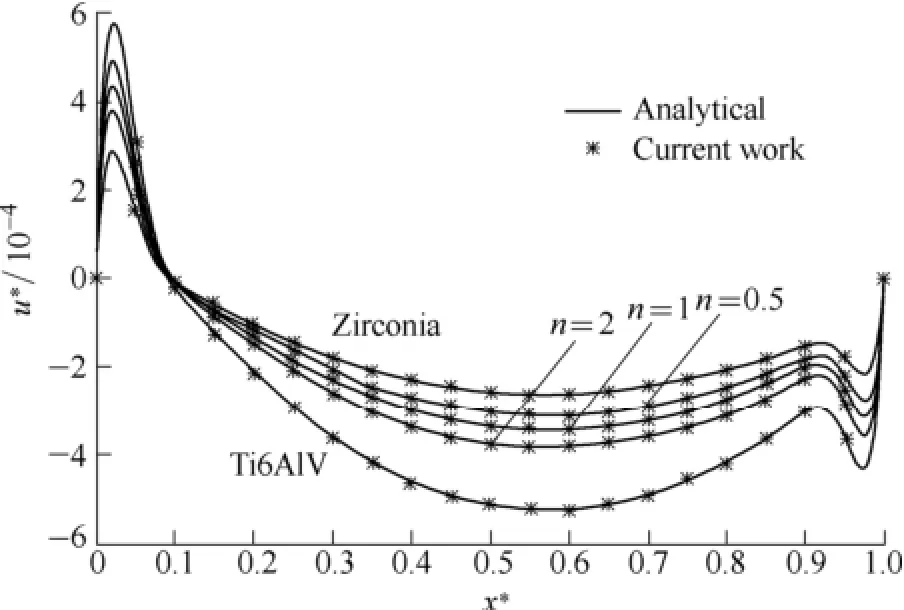
Fig. 6. Dimensionless axial displacement distribution along the inner surface of cylinder with constant thickness and non-uniform pressure

Fig. 7. Dimensionless radial displacement distribution along the inner surface of cylinder with varying thickness and uniform pressure
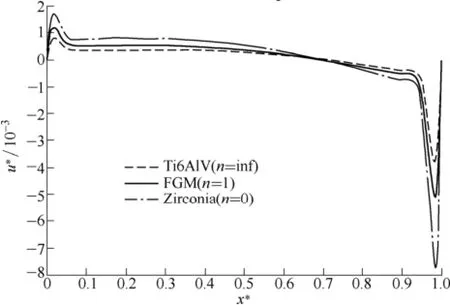
Fig. 8. Dimensionless axial displacement distribution along the inner surface of cylinder with varying thickness and uniform pressure
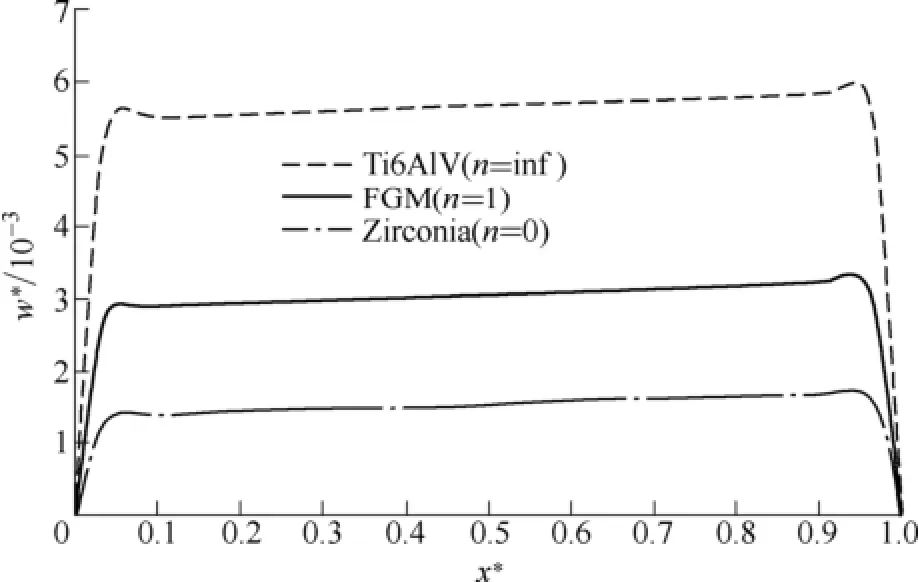
Fig. 9. Dimensionless radial displacement distribution along the inner surface of cylinder with varying thickness and non-uniform pressure
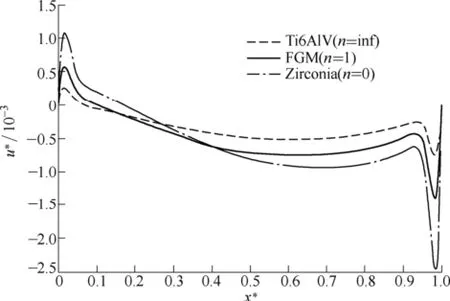
Fig. 10. Dimensionless axial displacement distribution along the inner surface of cylinder with varying thickness and non-uniform pressure
5 Conclusions
Perturbation method is applied for the elastic analysis of functionally graded cylinder with varying thickness and non-uniform pressure. The governing equations of general cylinder are obtained by First order Shear Deformation Theory (FSDT) and minimum total potential energy approach. Matched asymptotic method is applied to obtain mechanical behavior of cylinder. Inner solution for near boundaries and outer solution for points far from boundaries are obtained by perturbation series. General solution is combination of inner and outer solutions. The current study is compared to the existing numerical results,classical theory and analytical solution for appropriate cases. The capability of presented method in estimation of the displacement field for non-homogeneous cylinder with varying thickness and non-uniform pressure is shown. It is possible to increase the level of accuracy of current model by considering of higher-order theories such as third order shear deformation theory. With the help of the presented method it is possible to achieve an optimum design of cylinder in term of the thickness and materials according to pressure and temperature distribution along the cylinder.
[1] NZENGWA R, SIMO B H T. A two-dimensional model for linear elastic thick shells[J]. International Journal of Solids and Structures,1999, 36(34): 5141-5176.
[2] TUTUNCU N, OZTURK M. Exact solutions for stresses in functionally graded pressure vessels[J]. Composites Part B: Engineering, 2001, 32(8): 683-686.
[3] TUTUNCU N. Stresses in thick-walled FGM cylinders with exponentially-varying properties[J]. Engineering Structures, 2007,29(9): 2032-2035.
[4] AREFI M, RAHIMI G H. Comprehensive thermoelastic analysis of a functionally graded cylinder with different boundary conditions under internal pressure using first order shear deformation theory[J]. Mechanika, 2012, 18(1): 5-13.
[5] AREFI M, RAHIMI G H, KHOSHGOFTAR M J. Exact solution of a thick walled functionally graded pizeoelectric cylinder under mechanical, thermal and electrical loads in the magnetic field[J]. Smart Structures and Systems, 2012, 9(5): 427-439.
[6] AREFI M, RAHIMI G H, KHOSHGOFTAR M J. Optimized design of a cylinder under mechanical, magnetic and thermal loads as a sensor or actuator using a functionally graded piezomagnetic material[J]. International Journal of Physical Sciences, 2011, 6(27): 6315-6322.
[7] KHOSHGOFTAR M J, GHORBANPOUR ARANI A, AREFI M. Thermoelastic analysis of a thick walled cylinder made of functionally graded piezoelectric material[J]. Smart Materials and Structures, 2009, 18(11): 115007.
[8] RAHIMI G H, AREFI A, KHOSHGOFTAR M J. Electro elastic analysis of a pressurized thick-walled functionally graded piezoelectric cylinder using the first order shear deformation theory and energy method[J]. Mechanika, 2012, 18(3): 292-300.
[9] ZAMANI NEJAD M, RAHIMI G H, GHANNAD M. Set of field equations for thick shell of revolution made of functionally graded materials in curvilinear coordinate system[J]. Mechanika, 2009,77(3): 18-26.
[10] LIEW K M, KITIPORNCHAI S, ZHANG X Z, et al. Analysis of the thermal stress behaviour of functionally graded hollow circular cylinders[J]. International Journal of Solids and Structures, 2003,40(10): 2355-2380.
[11] JABBARI M, BAHTUI A, ESLAMI M R. Axisymmetric mechanical and thermal stresses in thick short length FGM cylinders[J]. International Journal of Pressure Vessels and Piping,2009, 86(5): 296-306.
[12] ZHANG W, HAO Y X, YANG J. Nonlinear dynamics of FGM circular cylindrical sheel with clamped-clamped edges[J]. Composite Structures, 2012, 94(3): 1075-1086.
[13] SHENG G G, WANG X. Thermal vibration, buckling and dynamic stability of functionally graded cylindrical shells embedded in an elastic medium[J]. Journal of Reinforced Plastics and Composites,2008, 27(2): 117-134.
[14] TORNABENE F, VIOLA E. Free vibration analysis of functionally graded panels and shells of revolution[J]. Meccanica, 2009, 44(3): 255-281.
[15] NAJAFIZADEH M M, ISVANDZIBAEI M R. Vibration of functionally graded cylindrical shells based on different shear deformation shell theories with ring support under various boundary conditions[J]. Journal of Mechanical Science and Technology, 2009,23(8): 2072-2084.
[16] SANTOS H, CMM Soares, CAM Soares, et al. A semi-analytical finite element model for the analysis of cylindrical shells made of functionally graded materials[J]. Composite Structures, 2009, 91(4): 427-432.
[17] GHANNAD M, NEJAD M Z. Elastic analysis of pressurized thick hollow cylindrical shells with clamped-clamped ends[J]. Mechanika,2010, 85(5): 11-18.
[18] GHANNAD M, RAHIMI G H, NEJAD M Z. Determination of displacements and stresses in pressurized thick cylindrical shells with variable thickness using perturbation technique[J]. Mechanika,2012, 18(1): 14-21.
[19] KHOSHGOFTAR M J, RAHIMI G H, AREFI M. Exact solution of functionally graded thick cylinder with finite length under longitudinally non-uniform pressure[J]. Mechanics Research Communication, 2013, 51: 61-66.
[20] RAHIMI G H, AREFI M, KHOSHGOFTAR M J. Application and analysis of functionally graded piezoelectrical rotating cylinder as mechanical sensor subjected to pressure and thermal loads[J]. Applied Mathematics and Mechanics(English Edition), 2011, 32(8): 997-1008.
[21] REDDY J N, KIM J. A nonlinear modified couple stress-based third-order theory of functionally graded plates[J]. Composite Structures, 2012, 94(3): 1128-1143.
Biographical notes
KHOSHGOFTAR M J, born in 1986, received his PhD degree from Tarbiat Modares University, Iran, in 2014. His research interests include advanced materials and analytic methods.
Tel: +98-9102041407; E-mail: mj.khoshgoftar@gmail.com
MIRZAALI M J, born in 1985, is a PhD candidate at Politecnico di Milano, Milan, Italy. His research interests include finite element analysis, biomechanics and fracture and damage mechanics.
Tel: +39 02 2399 8555; E-mail: mirzaali.mohammad@gmail.com
RAHIMI G H is currently a professor and a PhD candidate supervisor at Tarbiat Modares University, Iran. He received his PhD degree from UMIST, England. His research interests include composite materials, shells and plates analysis.
Tel: +98-21-82883356; E-mail: rahimi_gh@modares.ac.ir
Appendix


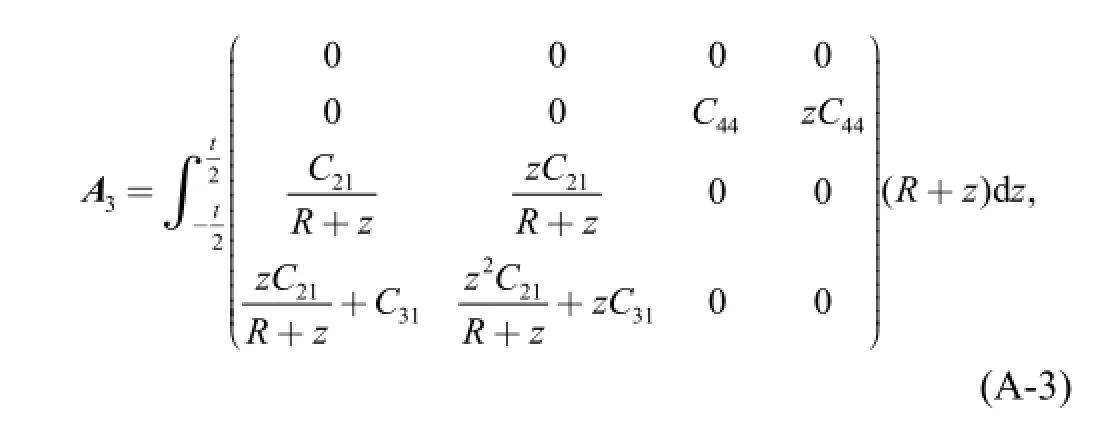
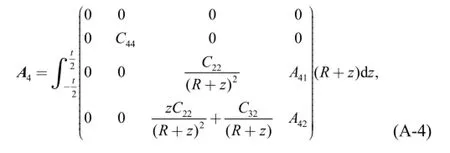
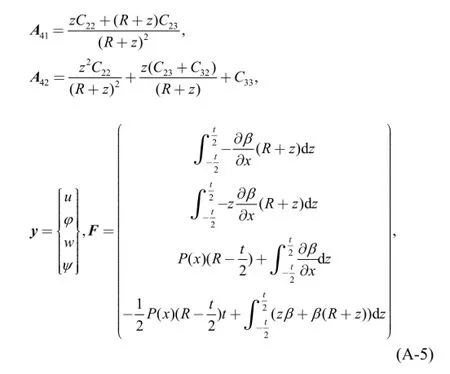

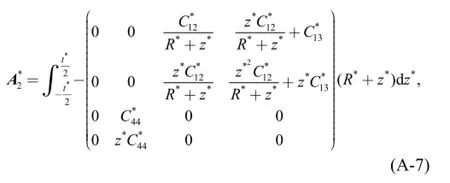
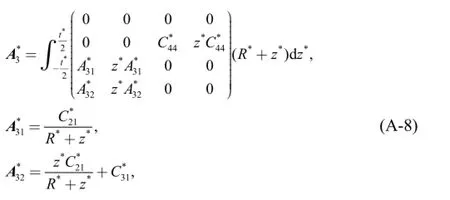
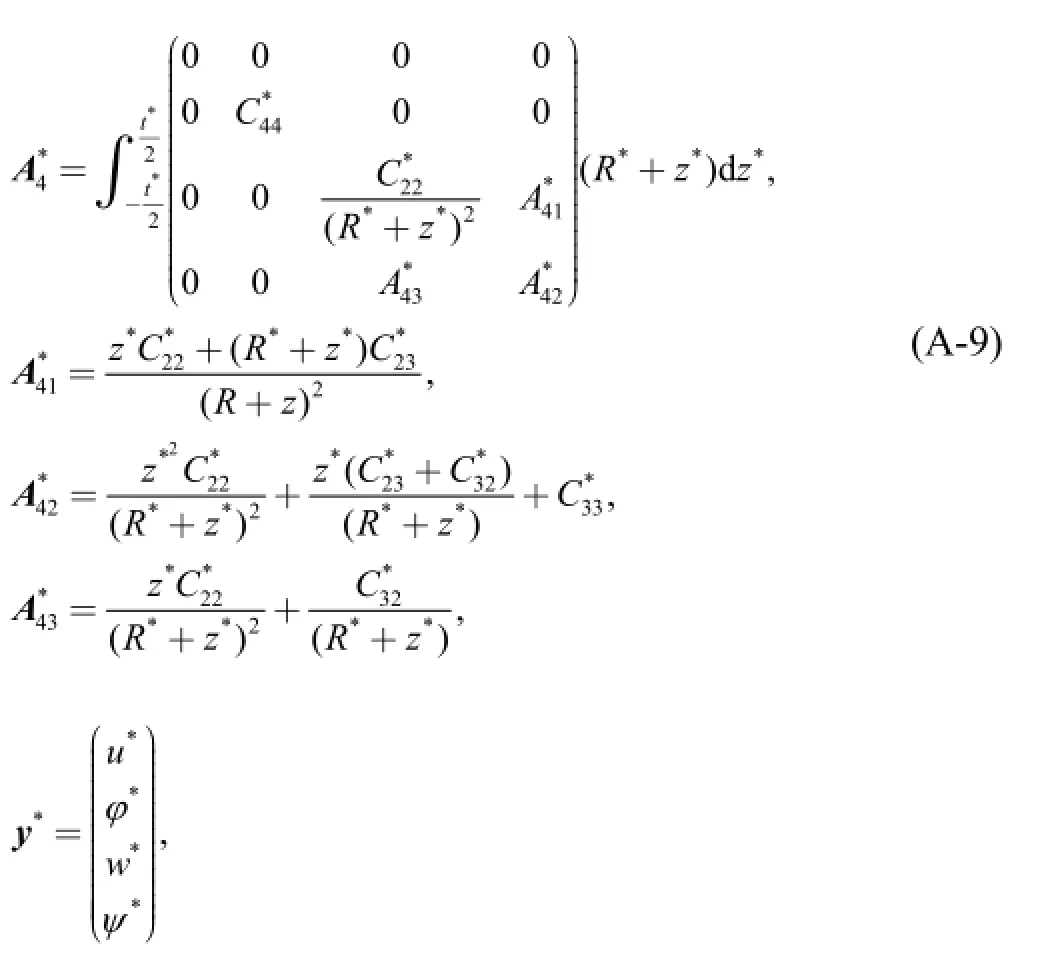
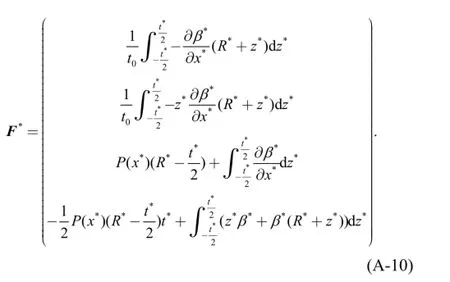
10.3901/CJME.2015.0429.048, available online at www.springerlink.com; www.cjmenet.com; www.cjme.com.cn
* Corresponding author. E-mail: mj.khoshgoftar@gmail.com
© Chinese Mechanical Engineering Society and Springer-Verlag Berlin Heidelberg 2015
July 15, 2014; revised April 27, 2015; accepted April 29, 2015
杂志排行
Chinese Journal of Mechanical Engineering的其它文章
- Influence of Alignment Errors on Contact Pressure during Straight Bevel Gear Meshing Process
- Shared and Service-oriented CNC Machining System for Intelligent Manufacturing Process
- Material Removal Model Considering Influence of Curvature Radius in Bonnet Polishing Convex Surface
- Additive Manufacturing of Ceramic Structures by Laser Engineered Net Shaping
- Kinematics Analysis and Optimization of the Fast Shearing-extrusion Joining Mechanism for Solid-state Metal
- Springback Prediction and Optimization of Variable Stretch Force Trajectory in Three-dimensional Stretch Bending Process
